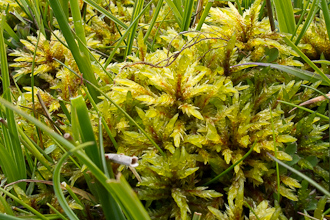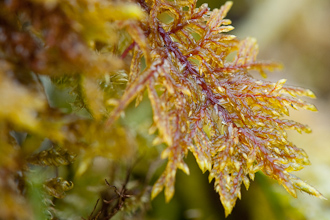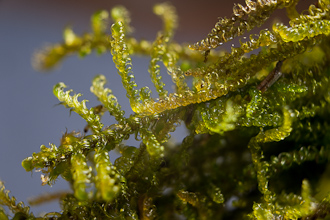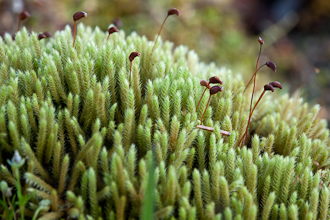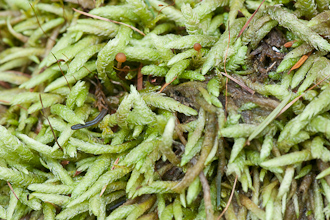
Moss characters
Shoot growth form and colour
Character menu
The character categories and their possible forms are:
-
Plant growth habit
-
Arrangement of the leaves
-
Details of the leaves
- Hairpoint:
-
Leaves recurved, hooked, squarrose
Note:
Apices bent abruptly to the side or downwards - Costa:
- Almost reaching tip of leaf
- Extending to about ½ or ¾ length of leaf
- Extending to about ¼ length of leaf
- Double nerve present
- Costa absent (or very inconspicuous)
- Teeth:
- Leaf margins:
- Leaf surface:
-
Reproductive structures
- Distinctive gemmae present:
- Colour of seta:
- Form of the capsule:
Note:
Distinctive capsules only.
Caution!
Please be aware of the following when using these character lists:
- One species may occur in more than one table, particularly for those characters that approach towards continuous variation.
- Mosses can take on quite different appearance and form depending on whether they are hydrated or dry.
- The lists of species are not comprehensive, but focus on common species that I've often found in Scotland.
- Many further characters could be added and I may do that in future.
- Clearly, a character that is shared by many species is less useful for discrimination than one found in a small number of species.
- The speculation as to the adaptive significance of various morphological characters is just that, speculation, and is not founded on specific research or extensive reference to the literature. However, it does draw on general biological knowledge and I judge the propositions as reasonable.
Moss on wall
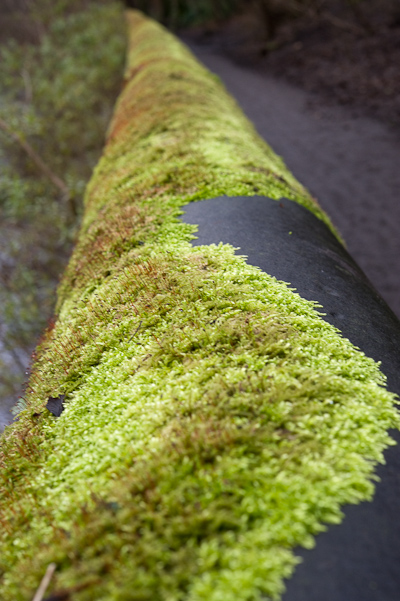
Even the smooth coping stones on the surface of this wall support a luxuriant growth of mosses. High humidity from being down in the deep gorge of the Water of Leith, Edinburgh, no doubt encourages such moss colonisation.
Tree or shrub-like
- Climacium dendroides
- Thamnobryum alopecurum
Few moss species have a distinct main shoot and a crown of smaller shoots, producing a tree or shrub-like form. Perhaps the best example of this growth form is shown by Climacium dendroides, which has some resemblance to a young conifer. The photo was taken on damp grassland near Corrie of Balglass in the Campsie Hills, near Fintry, Stirlingshire.
As seems to be the case for many robust mosses, both the species listed are characterised by wet or damp environments, the low water-stress perhaps being a factor in the development of large mosses.
As seems to be the case for many robust mosses, both the species listed are characterised by wet or damp environments, the low water-stress perhaps being a factor in the development of large mosses.
Pinnate branching
- Ctenidium molluscum
Note:
Ctenidium molluscum is not always very obviously pinnate. - Hylocomium splendens
- Pleurozium schreberi
- Thuidium tamariscinum
For this character I've combined species that have different degrees of pinnate branching. The photo shows the twice pinnate shoot of Hylocomium splendens. The moss was growing on limestone spoil at Crichton, Midlothian.
In this case I'll avoid any speculation on possible adaptive significance, as I can't imagine an adaptive role for one branching pattern over another. While branching itself obviously increases the photosynthetic surface area within a small region, perhaps the detailed nature of the branching pattern is more a function of the growth processes that have evolved in a given taxonomic group, rather than characters that have originated under environmental selection pressure.
In this case I'll avoid any speculation on possible adaptive significance, as I can't imagine an adaptive role for one branching pattern over another. While branching itself obviously increases the photosynthetic surface area within a small region, perhaps the detailed nature of the branching pattern is more a function of the growth processes that have evolved in a given taxonomic group, rather than characters that have originated under environmental selection pressure.
Irregular branching
- Calliergon giganteum
- Calliergonella cuspidata
- Cratoneuron filicinum
- Hypnum cupressiforme
- Hypnum jutlandicum
- Kindbergia praelonga
- Orthotrichum rivulare
- Palustriella commutata
- Pseudoscleropodium purum
- Rhytidiadelphus loreus
- Rhytidiadelphus triquetris
Palustriella commutata is characteristic of moist habitats, and the photo shows a small part of the moss collected from luxuriant patches in a calcareous burn at Crichton, Midlothian. Moist environments seem to favour not only an abundance of bryophytes, but the stature of the species tends also to be greater than that of species typical of more xeric environments.
Varied length of successively branching shoots and meandering shoot form, contribute to the somewhat untidy appearance of many mosses, especially when they are relatively large. In general, mosses with much branching tend to look a bit tangled compared to much-branched flowering plants. The latter usually show a decrease in width and length in successive branches and shoots, contributing a certain tidiness to the whole plant.
Varied length of successively branching shoots and meandering shoot form, contribute to the somewhat untidy appearance of many mosses, especially when they are relatively large. In general, mosses with much branching tend to look a bit tangled compared to much-branched flowering plants. The latter usually show a decrease in width and length in successive branches and shoots, contributing a certain tidiness to the whole plant.
Long, separate, erect shoots
- Bryum argenteum
- Bryum pseudotriquetrum
- Philonotis fontana
- Polytrichum spp.
As with many of these character tables, an element of judgement has to be made regarding what species to include, but tidy appearance is shared by all these species, as illustrated by the patch of Philonotis fontana photographed in Cushnie Forest, Aberdeenshire. For this list, I've included the comparatively short erect shoots of the Polytrichums and allies, and also mosses with long shoots closely packed together - Bryum pseudotriquetrum is almost carpet-forming and so perhaps doesn't satisfy the characteristic of being separate.
This appears to be a small category of mosses, and all the species in the table are actually quite varied in form, and favour varied substrates and environments. There isn't sufficient similarity to even begin to consider this growth form in adaptation terms.
This appears to be a small category of mosses, and all the species in the table are actually quite varied in form, and favour varied substrates and environments. There isn't sufficient similarity to even begin to consider this growth form in adaptation terms.
Forming prostate ribbon or string-like mats
- Leucodon sciuroides
- Plagiothecium undulatum
Note:
And leaves complanate, i.e. pressed against the shoot. - Pterygonium gracile
- Warnstorfia fluitans
Many mosses have a lax habit with prostrate shoots, but for this category I'm highlighting those species with long, thin, unbranched shoots.
Given the lack of supportive tissues in the shoots of most moss species, it seems a bit surprising how few mosses show this growth form. However, the list of species could probably be extended. Like the erect growth form, this character seems more a reflection of growth processes per se than of adaptation.
Given the lack of supportive tissues in the shoots of most moss species, it seems a bit surprising how few mosses show this growth form. However, the list of species could probably be extended. Like the erect growth form, this character seems more a reflection of growth processes per se than of adaptation.
Distinctly red shoots easily visible
- Bryum pseudotriquetrum
- Calliergonella cuspidata
- Hylocomium splendens
- Pleurozium schreberi
- Leucodon sciuroides
- Racomitrium ericoides
Note:
More orange than red. - Rhytidiadelphus loreus
- Rhytidiadelphus triquetris
Red shoots are conspicuous on a small number of mosses, but it's not a particularly helpful discriminating character, as all the species in the table are easily identified (although there may be further red-stemmed species).
The colour of the shoots isn't a growth habit, of course, but I've placed the character in this category as it's a feature of the shoots. I've no idea whether or not the coloration reflects some evolutionary adaptation to the environment.
The colour of the shoots isn't a growth habit, of course, but I've placed the character in this category as it's a feature of the shoots. I've no idea whether or not the coloration reflects some evolutionary adaptation to the environment.
